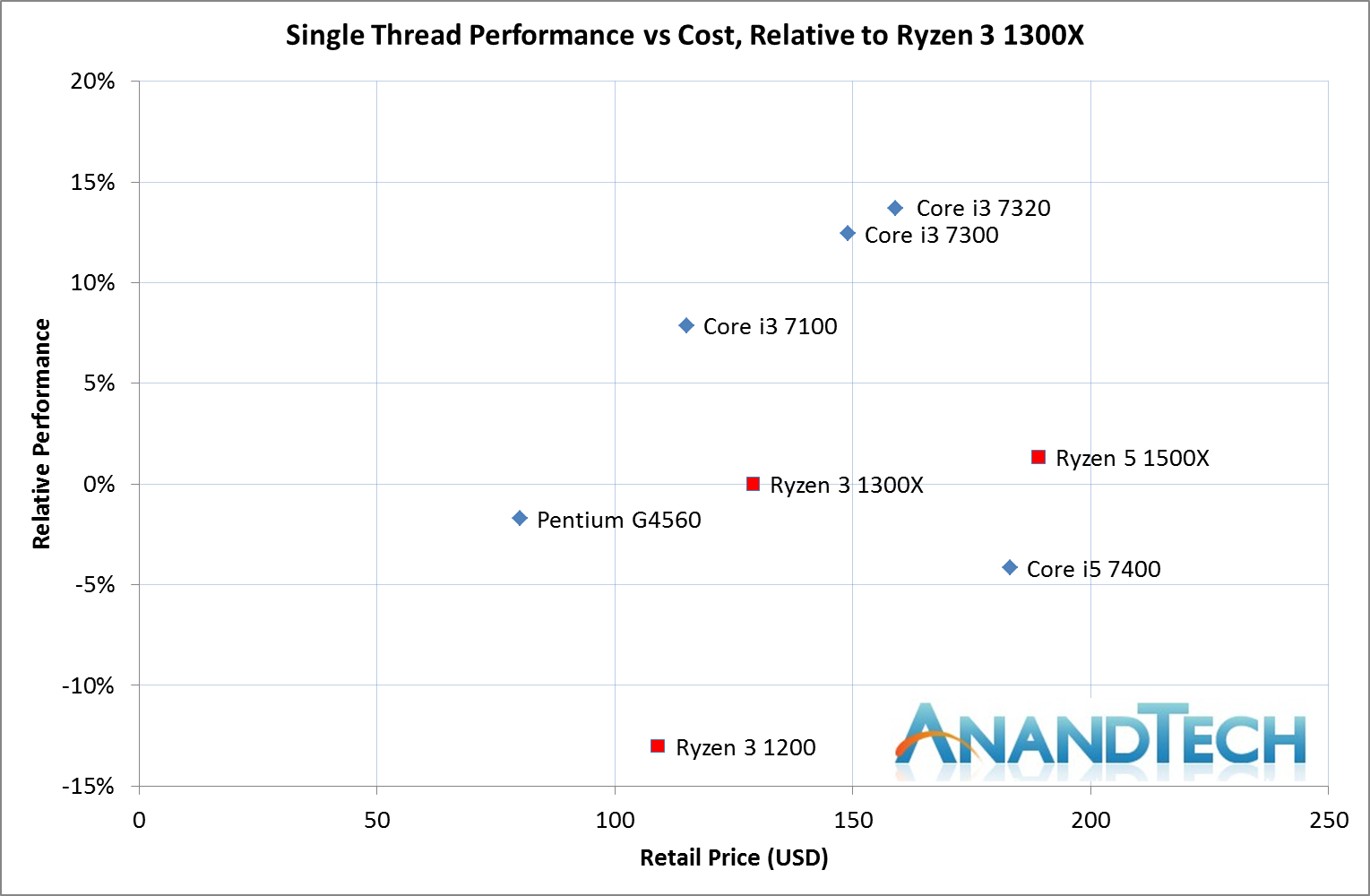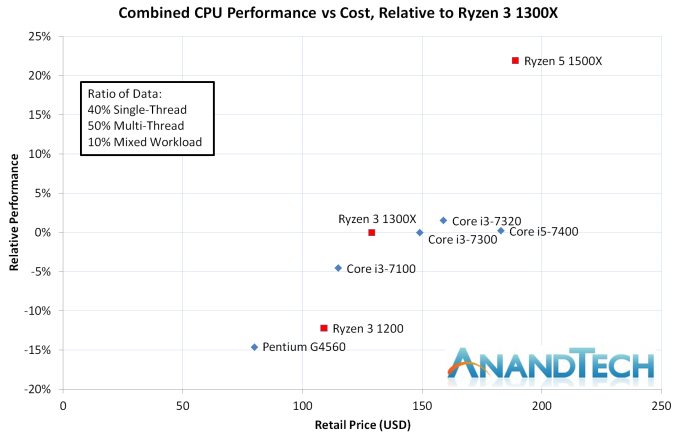The AMD Ryzen 3 1300X and Ryzen 3 1200 CPU Review: Zen on a Budget
by Ian Cutress on July 27, 2017 9:30 AM EST- Posted in
- CPUs
- AMD
- Zen
- Ryzen
- Ryzen 3
- Ryzen 3 1300X
- Ryzen 3 1200
Conclusion
For as much hype and excitement that has been generated around Zen and the Ryzen products so far, with everything focused on the high-end when we hit the lower elements of the stack and the volume parts, not much ‘excitement’ is to be had. We’ve already gone through the new fancy microarchitecture and the platform, and what matters at this end of the spectrum is a pure performance per dollar metric. So far the Ryzen 7 parts have certainly hit that goal, especially when originally compared to Broadwell-E when the Ryzen 7 parts per launched. For the Ryzen 3, the direct competition is Kaby Lake, and CPUs with a much higher IPC. But where Intel has two cores, AMD has four.
Diving straight into the graphs, the Single Thread performance graph is as follows. All data is shown relative to the performance of the Ryzen 3 1300X.
For the AMD CPUs, the 1300X and 1500X are near in base/turbo frequency (3400/3700 vs 3500/3700) and so score about the same, and the Ryzen 3 1200 at 3100/3400 scores about 13% lower.
The Intel CPUs here show a distinct curve from the Pentium G4560 at 3.5 GHz through the Core i3s at 3.9 GHz, 4.0 GHz and 4.1 GHz. The Core i5 7400 scores a lot lower here, with its base frequency of 3.0 GHz and a turbo up to 3.5 GHz.
For the multi-thread performance:
We shopped the graph here at +20% otherwise it would look odd, but the Ryzen 5 1500X with simultaneous multithreading gets a +40% boost over the 1300X, while the Ryzen 3 1200 sits again at around -12%. All the dual core intel parts lag behind here compared to AMD’s quad cores, although the Ryzen 3 1200 and the Core i3-7300 are closely matched – but the Ryzen wins on price by being ~$40 cheaper. The Core i5-7400, competes against the Ryzen 3 1300X here as they are both quad cores, and the Intel wins despite the lower frequency due to higher IPC – which comes at a $50+ premium.
For our combined all-in-one graph, we included our mixed workload data and weighted the results 40:50:10 for single:multi:mixed thread workloads.
If we ignore the Ryzen 5 1500X in the top right corner, there are a few stories here.
First is that the Ryzen 3 1200 does not look like an attractive option. It performs +2-3% of the Pentium but is $30 more expensive, and the Core i3-7100 beats it by 8% for only a sub-$10 cost.
Then there is the Ryzen 3 1300X. Compared to the Core i3-7300/7320 and the Core i5-7400, it clearly wins on performance per dollar all around. Compared to the Core i3-7100 though, it offers almost 5% more performance for around $10-15 more, which is just under 10% of the cost. Depending on budgets, each one could be an attractive option.
We’re still working through our gaming testing as this review goes live, and we’ll add graphs for that in a bit.













140 Comments
View All Comments
Gavin Bonshor - Thursday, July 27, 2017 - link
One of the hardest working men in the industry! :Dedlee - Thursday, July 27, 2017 - link
I dont understand the point of making a $100 cpu without an integrated gpu if you wanted to attract the lower end market, this is really silly mistake. Sort of like intel including an integrated gpu with i7-7700k, it doesnt make sense, 95% of those with a 7700k will buy a gpu, but someone who is looking for a lowend cpu is not going to buy a discrete graphics cards, its just sillyphoenix_rizzen - Thursday, July 27, 2017 - link
It really depends on the use case.For example, are there any integrated GPUs that support 3 monitors? I know a lot of them support dual monitors, but haven't come across any that support 3 (although I haven't looked that hard). My work PC is a low-profile desktop running an AMD Athlon-II x4 CPU and an Nvidia 730 GT GPU for tri-monitor setup. Upgrading the CPU/motherboard/RAM to a Ryzen 3 1300X would be a huge upgrade for this system.
90-odd % of the desktops in the schools here use AMD Athlon-II CPUs (graphics integrated into the chipset), with the rest using Intel Pentium CPUs (graphics integrated into the CPU). And we add Nvidia 210 or 730 GPUs to those that need better multi-monitor support or better 3D performance. Why do we do it that way? Cost. We try to keep the complete desktop system (case, motherboard,
CPU, at least 2 GB RAM, no storage of any kind) to under $200 CDN (they're diskless Linux stations). We have just shy of 5000 of those in the district right now.
We've avoided the Bulldozer-based APUs so far as the price/performance just wasn't there compared to the Pentium line (from our suppliers). But the Ryzen 3 looks like a decent upgrade. Will be interesting to see what the prices are like for it from our suppliers this winter/spring. Will also be interesting to see what the GPU side of the Zen-based APUs will be like next year.
The other important bit is driver support. We are a mostly Linux-using school district, so we tend to use hardware that's at least 2 steps back from the bleeding edge. That way, we get better prices, and better driver support.
edlee - Thursday, July 27, 2017 - link
i understand when upgrading from integrated to gpu like you stated in your use case, but from the low end price standpoint, a i3-7100 is cheaper because they dont need to add a gpu like the ryzen 3 needs, so its not competing on a performance standpoint or a price standpoint when you add the price of the cheapest gpuOutlander_04 - Friday, July 28, 2017 - link
Using an integrated gpu is usually a poor choice. Intels drivers are so dumbed down they are worse than hopeless.Factor in that using integrated means less system RAM available as well so performance can be reduced
Ratman6161 - Tuesday, August 1, 2017 - link
Many people may be starting out from the position of knowing that the integrated graphics on any of the Intel CPU's in the test are not good enough for them. If you know that from the start then the argument that AMD doesn't have an IGPU is meaningless. I'm also somewhat interested in seeing overclocking tests with the R3 as that is one thing you just don't get with Intel at this level short of the 7350K. I sort of suspect that an OC'd 1200 could but just as fast or faster than a 1300X (though at only a $20 difference I'm not sure how much it matters).Also, in more computationally intense tasks, the 1300x really doesn't do badly against the i5 that costs $53 more so once again, if you don't care about integrated graphics it could be a good choice for some people.
On the other hand, for someone for whom MS Office, email, and web browsing are their main uses, then something like the i3-7100 suddenly looks very attractive - or even the Pentium G.
In this segment, AMD really needs to get a Ryzen Based APU on the market. If they did a single CCX, 4 core and used the empty space vacated by the second CCX for a decent IGPU they could definitely have an i3 killer.
renw0rp - Thursday, July 27, 2017 - link
I had HP Folio 9470m with core i5-3437U and it was driving 3 * 1920x1200 screens without an issue. And it's ~2013 processor...3rd gen of Core processors was the first to support 3 displays. The 2nd gen supported just 2.
stuartlew - Thursday, July 27, 2017 - link
AMD Kaveri does three monitorsserendip - Friday, July 28, 2017 - link
Are there motherboards with integrated chipset graphics for Ryzen?I understand the good thing about adding a discrete GPU only to PCs that need one but not having an integrated GPU is nuts, for the mass market at least.
silverblue - Friday, July 28, 2017 - link
No, but Bristol Ridge launched yesterday, so there are now APUs that use AM4.